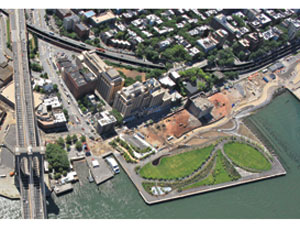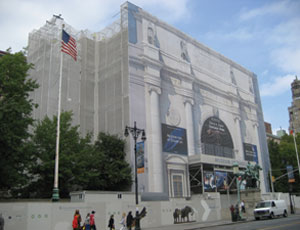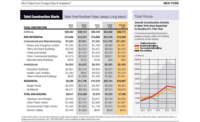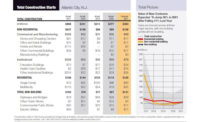New York is a center of commerce, a hubbub of construction activity, even in difficult economic times, but it’s also home to millions of people. Mindful of residents and the city’s visitors, the New York Building Congress/New York Building Foundation’s “Construction for a Livable City” initiative aims to enhance the industry’s image and improve bystanders’ quality of life by making worksites more attractive and enhancing community relations.


“The industry can do a lot to improve itself,” says Richard Anderson, president of the New York Building Congress. “There is a lot of room to dress up a construction site and make it look better and work better.”
The initiative began several years ago when the foundation’s design consultant suggested more attractive sidewalk sheds. That project grew into the livable city program, with a steering committee guiding the initiative and conducting pilot projects.
“It started with sidewalk sheds but quickly got into the appearance and functioning of the construction site,” Anderson says.
The steering committee looked to incentive programs and practices in Europe and developed 28 recommendations in four categories: operations and safety, environmental impact, image and design, and community relations. It creates a standard framework contractors can follow.
Many seem like common good business practices, such as keeping nuts, bolts and sharp objects protected, concealed or removed from public access; removing waste throughout the day and recycling it; and posting general information about the site and people to contact about the project.
“This is very reasonable, and many [people on the steering committee] said we are doing this already,” Andersons says. “But they are not doing all of it and not doing it on a consistent basis.”
The initiative will begin as a voluntary effort. Anderson says it could evolve into a program with formal participation, evaluation and awards provided to the most considerate contractors, as is done by the Considerate Constructors Scheme in the United Kingdom.
“These are broad suggestions that are ready for refinement,” says Andrew Hollweck, vice president of the New York Building Congress. “We are hoping the industry looks at the report, implements the recommendations and tells us thoughts about creative ways that can be replicated.”
Several pilot projects have already embraced the livable city tenets.
Brooklyn Bridge Park Skanska USA Build-ing of New York embraced the livability plan’s attributes on its $350 million Brooklyn Bridge Park project, which was broken into five phases due to an inability to procure funding for the entire job.
“The biggest thing was making sure all the different communities in the diverse neighborhood were involved and stayed abreast of all the activities going on,” says James Robinson, project executive with Skanska, which received the $105 million contract for the first two phases. The project wrapped up earlier this year.
Two areas, the northern most and southern most segments proceeded, while the Brooklyn Bridge Park Corp. worked to secure more funding. Skanska erected banners, connecting the two sections of the park, to keep people informed about the park’s progress. The company also took steps to reduce noise and dust and monitored air quality. Neighbors could voice concerns during public meetings. Minorities and women received more than 30% of the work.
“This checklist, we adhered to without issue, because we weren’t in a confined, constructed site,” says Robinson, adding that in other locations some of the elements of the livable city recommendations could be more challenging. “The project came in under budget, on time and safe.”
American Museum of Natural History
While restoring the fa�ade at the American Museum of Natural History, Bovis Lend Lease of New York has installed scaffolding and fencing painted to resemble the stone cladding the building, so it melds into the building. The fencing also provides information about the project. On the inside scaffold where mural restoration is taking place, construction netting and a scrim have been colored to blend in with the stone.
“We’ve tried to make it less objectionable and more friendly to the public,” says David Reese, vice president of Bovis. “It’s important for the museum, which has an image to maintain. It’s the right thing to do for the public-visitor experience.”
Reese acknowledges the extra steps add to project costs, compared to doing the bare minimum required by law. However, he said part of the payoff is the building continues to give the appearance of being open and welcoming for visitors, allowing the owner to maintain attendance levels. Construction began in March and Reese anticipates completing it in spring 2011. He would not release a cost.
Metro North Facilities Upgrades at Grand Central Terminal
F.J. Sciame Construction Co. of New York came up with a creative solution to logistical issues associated with expanding Metro North’s facilities at Grand Central Terminal and upgrading the landmark’s HVAC and electrical infrastructure. The work required adding a two-level structural deck at the existing tennis courts and involved bringing steel beams, a metal deck and other materials into the busy station without interfering with rail, passenger or vehicle traffic.
“This building encompasses an extra-ordinary amount of challenges,” says Steve Colletta, vice president of Sciame in charge of the Metro North project.



Post a comment to this article
Report Abusive Comment